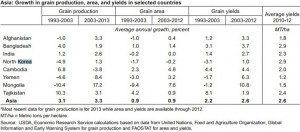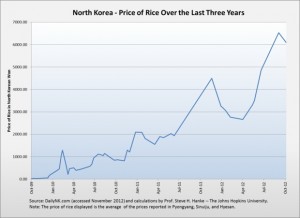Institute for Far Eastern Studies (IFES)
2012-12-27
The price of rice in North Korea along with the exchange rate declined slightly in October 2012 but began to rise sharply this month, near the one-year anniversary of Kim Jong Il’s death on December 17.
According to “North Korean Market Trends,” published by the online newspaper Daily NK, the price of rice on December 10 in Pyongyang, Sinuiju, and Hyesan, were reported to be 6,400 KPW, 6,800 KPW, and 6,500 KPW, respectively. This is a 300-700 KPW/kg increase from the previous month.
Even the exchange rate against the US dollar increased dramatically in these three cities: 7,800 KPW in Pyongyang, 8,000 KPW in Sinuiju, and 8,450 KPW in Hyesan. This was a jump of 1,500 KPW, 1,300 KPW, and 2,000 KPW in the respective cities against last month.
This is the highest recorded exchange rate, beating the September rate of 6,370 KPW in Pyongyang.
The Daily NK quoted an unnamed North Korean source, explaining the reason for such jump in prices and exchange rate is due to blockage of trade with China during the mourning period for Kim Jong Il and merchants began to withhold rice and dollars from the market.
The North Korean authorities announced to its people on December 5 that the mourning period for Kim Jong Il would run from December 7 to 18, and that manufactured goods from China would not be permitted to enter the country. Immediately following this decision, the exchange rate and prices began to skyrocket. Residents’ complaints escalated, forcing North Korean authorities to re-open the border to allow goods from China to enter the country again.
The North Korean source explained the unannounced decision to halt trade with China angered the North Korean residents as most goods in the market are from China and it resulted in soaring prices and withholding of US dollars as people’s sense of insecurity began to rise.
Some believe the ban on Chinese imports was reversed quickly as negative sentiments among the North Korean people began to escalate. North Korean authorities established market control policy during the mourning period to maintain order but this ended shortly for the fear of adverse effects from the new policy.


